Last Updated on January 20, 2024 by Greg Gillson
Did you see a brightly-colored red bird, orange bird, or yellow bird in Tennessee and wonder what is was?
This page is for you!
This article shows you photos and identification of some of the most common birds in Tennessee based on color.
The list of birds found in Tennessee includes over 435 species. So, I can’t show you all of them. I’m going to assume that you saw a common bird of this color, but you certainly could have seen something less common, or even rare!
Shape (including the shape of the bill) and size are often more helpful in starting to identify a bird than the color. In fact, most birds in North American can be easily identified with a black-and-white photo!
Many birds are multi-colored, so that it may be hard to pick out a dominant color. Males and females may be colored quite differently. And some color patterns are similar among otherwise dissimilar species.
Nevertheless, I’m going to try to pick out some of the birds that you are most likely to see in backyards or towns. And I’ll show a few others that I get asked about a lot.
The birds with a noticeable amount of red on them in Tennessee covered in this article are:
- Northern Cardinal
- American Robin
- House Finch
- Ruby-throated Hummingbird
- Summer Tanager
- Scarlet Tanager
- Red-headed Woodpecker
- Rose-breasted Grosbeak
The birds with a noticeable amount of orange on them in Tennessee covered in this article are:
- Eastern Towhee
- Brown Thrasher
- Barn Swallow
- Red-shouldered Hawk
- American Kestrel
- Wood Thrush
- Cooper’s Hawk
- Orchard Oriole
- American Redstart
The birds with a noticeable amount of yellow on them, including lots of yellow and black birds, in Tennessee covered in this article are:
- American Goldfinch
- Yellow-rumped Warbler
- Northern Flicker
- Eastern Meadowlark
- Cedar Waxwing
- Common Yellowthroat
- Northern Parula
- Great Crested Flycatcher
- Pine Warbler
- Yellow-breasted Chat
- Black-throated Green Warbler
- Hooded Warbler
- Yellow-throated Vireo
- Yellow-throated Warbler
- Palm Warbler
- Magnolia Warbler
Red birds of Tennessee
Birds get the red, orange, and yellow in their feathers from carotenoids in the fruit, seeds, and plants they eat (source).
These carotenoid colors combine with melanin to form an infinite range of red feathers–pink, rusty, scarlet, violet, red-orange.
The following are red birds that you are most likely to see in Tennessee.
Northern Cardinal
These are one of the most common backyard birds in the eastern United States. Their bright red color and unique head profile makes them instantly identifiable to most people–whether they are bird watchers or not!
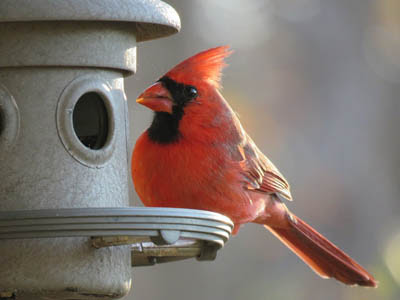 |
| Northern Cardinal. GeorgeB2 from Pixabay. |
Males of these large seed eaters are bright red with a black face and red crest.
Females replace most of the red with brown, The bill is large and orange.
These birds are found in woodlands, stream edges, residential areas.
Northern Cardinals year-round residents throughout Tennessee.
American Robin
These are familiar lawn birds with red breasts.
 |
| American Robin. Greg Gillson. |
Male American Robins are brownish-gray above with a brick red breast.
Females are paler orange below and paler gray above.
They are widespread in open country with scattered deciduous trees, residential areas.
American Robins are year-round residents throughout Tennessee.
House Finch
When people ask about a bird with a red head at their feeder, it is usually this bird.
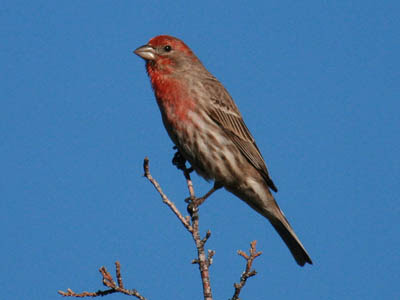 |
| Male House Finch. Greg Gillson. |
Males of this dusty brown striped finch have red limited to the head (specifically the forehead and eyebrow), breast (chest), and rump. The red coloration tends toward orangish, and may rarely be yellowish.
Females are streaked, similar to the males but without red. They lack any strong pattern on the face and head.
Note the small round head and curved upper ridge on the bill.
Some people call these red-headed sparrows. Sparrows and finches are similar, but in general, male finches are brighter than the females and tend to hang out more in trees. Sparrow genders are usually quite similar in coloration and tend to feed mostly on the ground.
These birds are common in residential areas, especially at bird feeders. In the West more widespread in arid regions near water.
House Finches are year-round residents throughout Tennessee.
Ruby-throated Hummingbird
These red-throated birds are the only hummingbird nesting in the eastern United States.
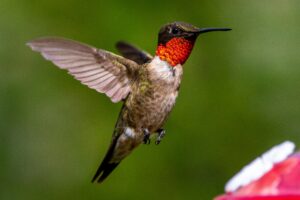
Males are dark green above and on the belly. They have a white upper chest. The throat is ruby-red.
Females are green above, white below, including white throat.
These birds are found in woodland edges, residential yards. Readily come to hummingbird feeders.
Ruby-throated Hummingbirds are summer residents throughout Tennessee.
Summer Tanager
These bright red birds are found toward the tops of tall trees in the southern United States.
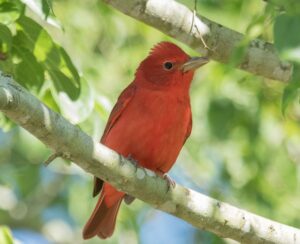
Males are rose red with fairly heavy bill.
Females are yellowish or mustard-colored, some with a faint reddish wash.
In the East these birds are found in pine-oak woodlands. In the West they prefer tall cottonwood trees.
Summer Tanagers are summer residents throughout Tennessee.
Scarlet Tanager
A brilliant red and black bird!
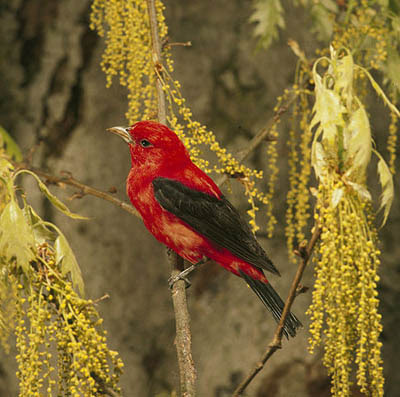 |
| Male Scarlet Tanager. USF&WS. Public Domain. |
Males are unmistakable with brilliant red with black wings and tail.
Females are olive-green above, darker wings and tail, yellower under parts. Pale bill.
These birds live in deciduous woods.
Scarlet Tanagers are summer residents throughout most of Tennessee, spring and fall migrants only in extreme western Tennessee.
Red-headed Woodpecker
These well-known woodpeckers with red heads have a fitting name.
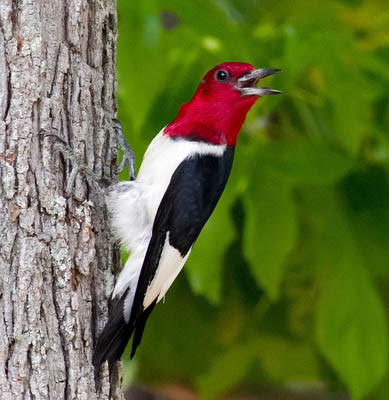 |
| Red-headed Woodpecker. Public domain. |
These birds have the entire head bright deep red. Back and tail black. Underparts white, as are inner secondaries and rump.
They are found in a variety of wooded habitats. They prefer to have oak and beech trees available. Sometimes come to feeders in winter.
Red-headed Woodpeckers are year-round residents throughout most of Tennessee, absent in mountains of eastern Tennessee.
Rose-breasted Grosbeak
These birds with the red breast and huge pink bill sing beautiful robin-like songs from the tops of trees.
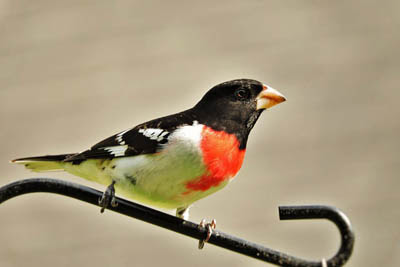 |
| Male Rose-breasted Grosbeak. Susan Killian. Pixabay. |
Males have black hood and upper parts. White under parts. Large white wing patches. Huge pink bill. Inverted bright red triangle on the breast.
Females are brown above, face with broad stripes, white throat. The under parts are buff with many thin brown streaks. Pale bill.
These birds inhabit deciduous and mixed forests. Shade trees in town. Come to feeders.
Rose-breasted Grosbeaks are spring and fall migrants throughout Tennessee, local summer residents in mountains of eastern Tennessee.
Orange birds of Tennessee
True orange-colored birds are not that common. Many birds that I have here are paler rusty.
The common pattern is an orange body and black or brown wings and tail. Another common pattern is for the orange to be restricted to the under parts.
The following are orange birds that you are most likely to see in Tennessee.
Eastern Towhee
These birds with rusty-orange sides like to hide in dense bushes.
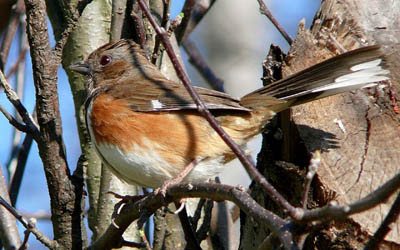 |
| Female Eastern Towhee. Skeeze. Pixabay. |
Males are black above with white wing patch, white tail corners. The sides are rusty. The belly white. Eyes variable: brown, red, orange, white, tending toward whiter southward.
Females are similar, but upper parts brown.
These birds are found in forest understory, dense brush, backyard hedges. Come to feeders.
Eastern Towhees are year-round residents throughout most of Tennessee, summer residents only in the mountains of eastern Tennessee.
Brown Thrasher
These are rather large rusty-orange songbirds.
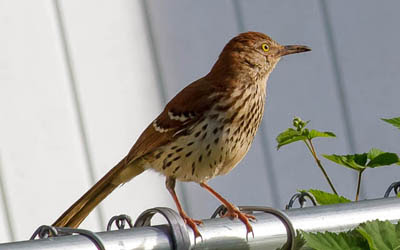 |
| Brown Thrasher. Linda Jones CC0. |
The upper parts of these birds is colored rusty-brown to orange. They show two white wing bars. Under parts are buff with heavy reddish-brown streaking.
These birds live in woodland edges and mature backyard landscaping.
Brown Thrashers are year-round residents throughout Tennessee.
Barn Swallow
These orange-bellied birds are a familiar sight across North America in summer.
 |
| Barn Swallow. Greg Gillson. |
These birds are purple-blue above with orange under parts and long forked tails. The color of the underparts in winter or on females are often cinnamon or buff-colored, but breeding males can be brighter orange-red.
These birds swoop low over fields and wetlands at lower elevations. They may build their mud nests in rafters on porches, garages, or other out-buildings.
Barn Swallows are summer residents throughout Tennessee.
Red-shouldered Hawk
Okay, the shoulders are reddish. But the rusty-orange breast and wing linings are barred red too.
 |
| Red-shouldered Hawk. Greg Gillson. |
The upper parts are barred black and white. The tail is banded black and white. In adults the breast is barred orange.
Immature birds are streaked with brown on the breast.
These birds like woodland edges, residential edges, riparian groves.
Red-shouldered Hawks are year-round residents throughout Tennessee.
American Kestrel
These are the familiar small rusty-orange falcons sitting on power lines on the edge of the highway, or hunting and hovering over the median strip.
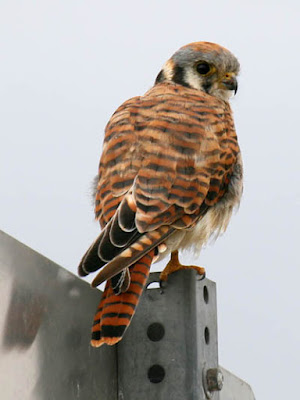 |
| Female American Kestrel. Greg Gillson. |
Females are rusty orange barred with black on their back wings and tail. The under parts are buff with black spots. The head shows two facial stripes.
Males have blue-gray backs and rufous tail is unmarked except for black tail band.
These birds are found in open country, farms, pastures with perches.
American Kestrels are year-round residents throughout Tennessee.
Wood Thrush
These spotted birds with the orange-brown upper parts tend to hide in understory trees and on the forest floor.
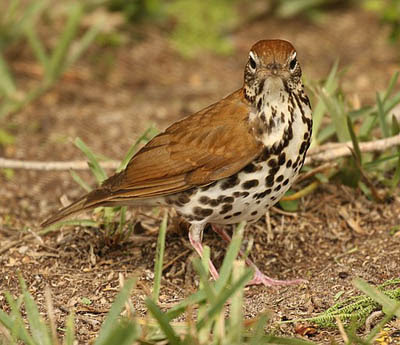 |
| Wood Thrush. Tony Castro. CC BY-SA 4.0 |
These birds are reddish brown on the upper parts, especially rusty orange on the crown and upper back. White eye ring. Large heavy black spots on the under parts.
They live in deciduous and mixed woods. Spend much time on the ground, shuffling through the leaf litter.
Wood Thrushes are summer residents throughout Tennessee.
Cooper’s Hawk
These crow-sized hawks with reddish orange bars on the under parts may show up in fall or winter to hunt birds at your feeder. Oh no!
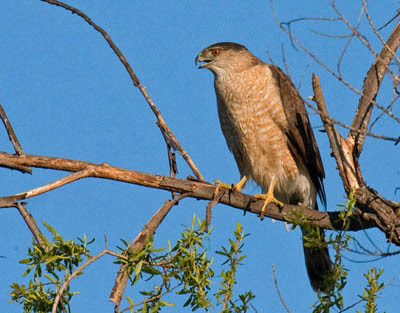 |
| Cooper’s Hawk. Greg Gillson. |
Adults with long gray and black banded tail. Dark gray above and cap on head. Under parts barred with rusty orange.
Immatures similar, brownish, streaked with brown on under parts.
Found in forests and woodlands, residential shade trees.
Cooper’s Hawks are year-round residents throughout Tennessee.
Orchard Oriole
Males of these orioles are darker rustier-orange than most other orioles in the United States.
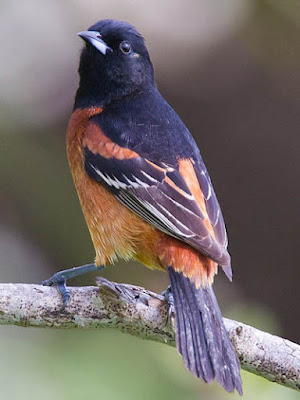 |
| Orchard Oriole. Dan Pancamo. Flikr. CC BY-SA 2.0 |
Males have a black hood and back, black wings and tail. The under parts are rusty-orange or even chestnut-brown.
Females are greenish above, lemon yellow below. They have 2 thin white wing bars. The bill is thinner than many other orioles.
They are found in orchards and residential shade trees.
Orchard Orioles are summer residents throughout Tennessee.
American Redstart
In flight these small warblers flash orange or yellow in the wing and base of the tail.
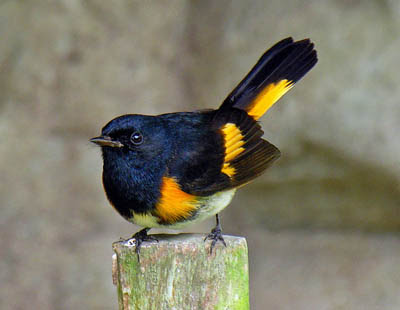 |
| American Redstart. Dennis Jarvis. Flikr. CC BY-SA 2.0 |
Males are black above, white on the belly. They have bright orange patches on side of breast, wings, and base of the tail.
Females are grayer, especially on the head. The orange of males is replaced by yellow on the females.
These birds are found in regenerating woods after a clear cut, and willow tangles along streams.
American Redstarts are summer residents in eastern and southern Tennessee, spring and fall migrants only in north-central and northwestern Tennessee.
Yellow birds of Tennessee
Yellow is a common bird color! Often it is mixed with black and white plumage in birds.
Many birds with darker upper parts have yellow breast or belly.
The following are yellow birds you are most likely to see in Tennessee.
American Goldfinch
These small little birds are bright yellow and black.
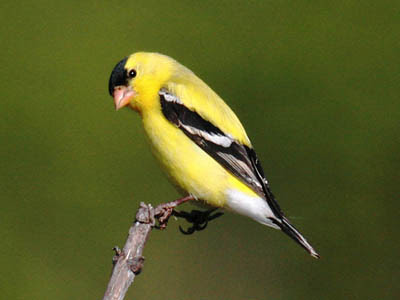 |
| American Goldfinch. Greg Gillson. |
Males are bright lemon yellow with black and white wings and tail, black cap. White under tail coverts. Pink bill.
Females are duller yellow below and brownish above. Lack black cap.
Winter birds are pale brown or gray, a touch of yellow on the throat of males.
These are birds of open country, fields with saplings, clear cuts, residential areas. They avoid dense forests, mountains, deserts. They visit feeders.
American Goldfinches are year-round residents throughout Tennessee.
Yellow-rumped Warbler
These are abundant warblers across North America. Affectionately called “butter butts” by many birders, because of their bright yellow rumps that flash in flight.
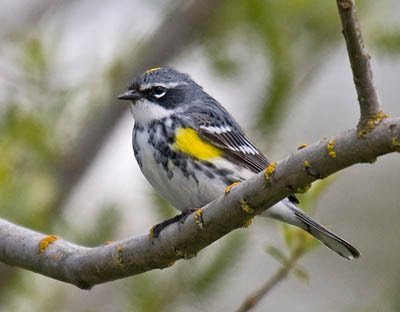 |
| Summer Yellow-rumped (Myrtle) Warbler. Greg Gillson. |
Western form (Audubon’s) with bright yellow throat and yellow rump. Large white wing patch.
Northern and Eastern form (Myrtle) with white throat, yellow rump, and two white wing bars.
Winter birds are dull gray brown, with bright yellow rump. Throat may be cream colored or white. Often difficult to tell the two forms apart in winter.
 |
| Winter Yellow-rumped Warbler. Greg Gillson. |
Breed in mountain or boreal conifers. Widespread in migration. Winter in low river bottoms, open weedy deciduous areas. Rarely come to feeders in winter.
Yellow-rumped Warblers are winter visitors throughout Tennessee.
Northern Flicker
These woodpeckers spend much time eating ants on the ground.
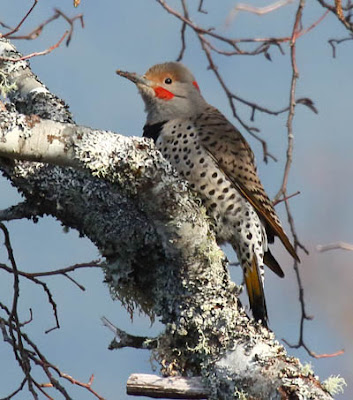 |
| Northern Flicker. Greg Gillson. |
These birds are larger than robins with brown and black barred upper parts. The underparts are pink with round black spots. There is a black crescent across the chest. When they fly away from you they reveal a large white rump.
Western birds have salmon-red under wings and under tail. Those in the East are colored yellow. The male face differs between the two populations–black whisker on the eastern birds, red whisker on western birds. Intergrades from overlap on Great Plains common. These may show male facial characteristics of both populations, or yellow-orange flight feathers.
These birds live in open woods with bare ground for foraging, residential yards.
Northern Flickers are year-round residents throughout Tennessee.
Eastern Meadowlark
These pale brown birds with the brilliant yellow breasts are home on the ground in prairies. They sing from perches on isolated trees, power poles, fence posts.
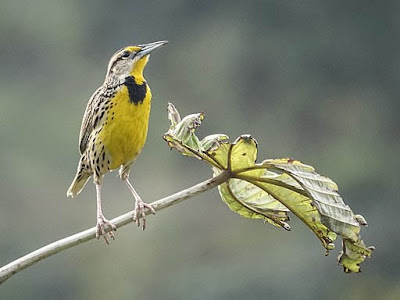 |
|
Eastern Meadowlark
Photo by Mike’s Birds from Riverside, CA, US [CC BY-SA 2.0]
|
The upper parts are streaked black, white, brown, so they blend into the dried grass where they live. The under parts are bright yellow with a black necklace across the chest. Very similar to Western Meadowlark, best told apart by spring song.
These birds live in prairies and extensive pasture lands.
Eastern Meadowlarks are year-round residents throughout Tennessee.
Cedar Waxwing
These crested birds with yellow band on the end of the tail are often found in flocks. They eat flying insects in summer, fruit and berries the rest of the year.
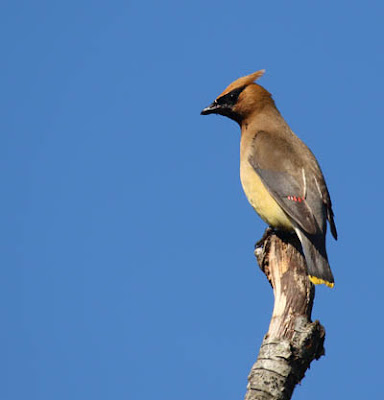 |
| Cedar Waxwing. Greg Gillson. |
These birds are fawn-brown above, with dark gray wings and tail. They have a black mask and wispy crest. The belly is yellow. The wings have waxy red drops on the end of the tertials. The end of the tail has a brilliant yellow tail band.
They are found in open habitats with berries, including juniper woodlands and towns in winter.
Cedar Waxwings are year-round residents in central and eastern Tennessee, winter visitors only in western Tennessee.
Common Yellowthroat
These buttery yellow birds are abundant in the marsh vegetation.
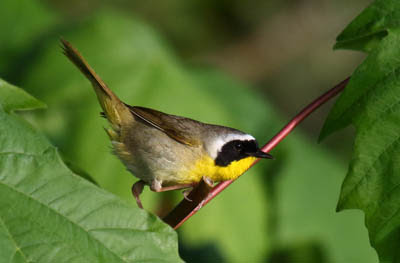 |
| Male Common Yellowthroat. Greg Gillson. |
These skulkers have bright yellow throats and yellow undertail coverts. Males have a black domino mask edged broadly in white, which females lack. Upperparts are dull olive-green.
Immature males in fall show a shadowed black mask.
Found in damp situations and heavy deciduous brambles following clear cuts.
Common Yellowthroats are summer residents throughout Tennessee.
Northern Parula
This is a handsome blue and yellow warbler.
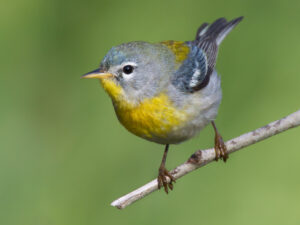
Males are blue on the hood and shoulders. Back green. Yellow throat and breast with a dark red spot mid-chest. Broken white eye ring. Two wide white wing bars.
Females are similar, but paler.
They are found along streams and in swampy forests with willows, maples, birches, hemlocks and other trees.
Northern Parulas are summer residents throughout Tennessee.
Great Crested Flycatcher
These flycatchers have long tails and big heads with big bill and bright yellow belly.
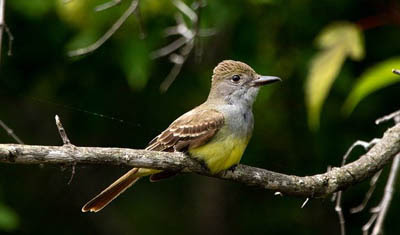 |
| Great Crested Flycatcher. Simard Francois. Pixabay. |
These birds are gray on the face and breast, brownish on rest of upper parts. Bright lemon yellow belly. The under side of the tail and some feathers of the wing are cinnamon colored.
These birds stay in the canopy of open woods.
Great Crested Flycatchers are summer residents throughout Tennessee.
Pine Warbler
This yellow and gray bird is one of the few warblers to visit feeders–and the only one to eat seeds!
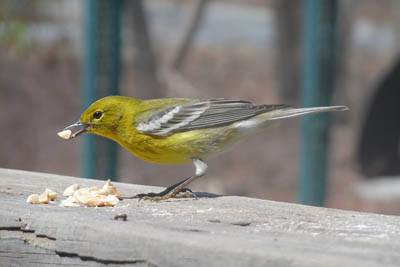 |
| Pine Warbler. Nikolaus Schultz. Pixabay. |
These birds are yellow-green on head, back, and breast. Wings blue-gray with wide white wing bars. Yellow split eye ring.
Strongly associated with pine forests. Usually high in tree tops.
Pine Warblers are summer residents throughout Tennessee.
Yellow-breasted Chat
These unique larger yellow birds may sing day and night, and include whistles and crow-like cawing, often given in a display flight.
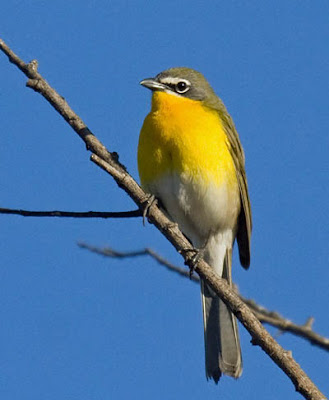 |
| Yellow-breasted Chat. Greg Gillson. |
These birds are greenish above with bright yellow breast and white belly. They have a dark mask bordered with white.
These birds live in tangles and wet woods.
Yellow-breasted Chats are summer residents throughout Tennessee.
Black-throated Green Warbler
Look for these birds with the yellow faces singing high up in the trees in spring.
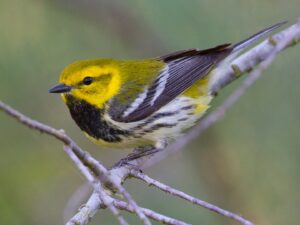
Males in spring have green back and crown, black throat, circling a bright yellow face.
Females and immatures in fall have a white throat. Greenish ear patch.
Found in many forest types, conifers, mixed forests, and cypress.
Black-throated Green Warblers are summer residents in the mountains of eastern Tennessee, spring and fall migrants only in the rest of Tennessee.
Hooded Warbler
These birds are found low down in the forest understory. They flash white tail corners.
 |
| Male Hooded Warbler. Christopher O’Toole. Pixabay. |
Males are dark green above with a black cowl over the crown and onto the throat. Face and under parts are bright yellow. White tail corners.
Females are similar, but lack the black of the male. The crown is green and the throat yellow.
These birds are found in deciduous woods and swamps, primarily in brushy understory.
Hooded Warblers are summer residents throughout Tennessee.
Yellow-throated Vireo
Vireos are slow moving small birds that sing throughout the day. These yellow-headed vireos are one of the most colorful of their clan.
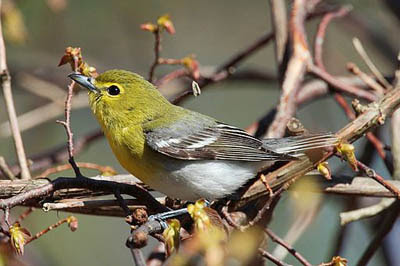 |
| Yellow-throated Vireo. MDF. CC BY-SA 3.0 |
These birds are blue-gray above, white below. Two white wing bars. Their head is olive yellow with yellow spectacles around the eye, and bright yellow throat.
These birds like large tracts of unbroken deciduous or mixed woodlands. Interestingly, however, they are often found on forest edges.
Yellow-throated Vireos are summer residents throughout Tennessee.
Yellow-throated Warbler
These birds with the bright yellow throats creep along the branches high in trees.
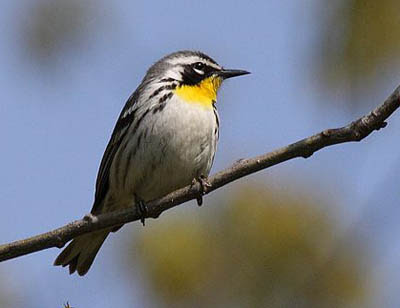 |
| Yellow-throated Warbler. Dominic Sherony. CC 2.0 |
These are rather gray warblers with bright yellow throat and upper breast. Black crown and face mask with white patch behind. White eyebrow. Two broad white wing bars. Black streaks on white breast and belly.
They like pine-oak woodlands, sycamores, cypress.
Yellow-throated Warblers are summer residents throughout most of Tennessee, spring and fall migrants only through mountains of eastern Tennessee.
Palm Warbler
This rather drab bird has bright yellow under tail coverts. It tends to spend much time on the ground in disturbed soils. It constantly bobs its tail up and down.
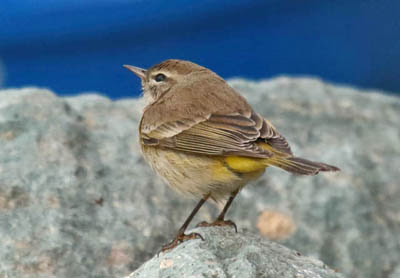 |
| Winter Palm Warbler. Greg Gillson. |
Breeding birds are rather gray with yellow throat, vent and under tail coverts. White eyebrow stripe. Chestnut cap. Eastern birds tend to be more yellowish on the breast.
In winter birds are very pale, but with yellow under tail.
They nest in bogs within boreal forests. They like similar habitat at other times of year: open land with isolated scrubby trees or bushes, including coastal scrub.
Palm Warblers are spring and fall migrants throughout Tennessee.
Magnolia Warbler
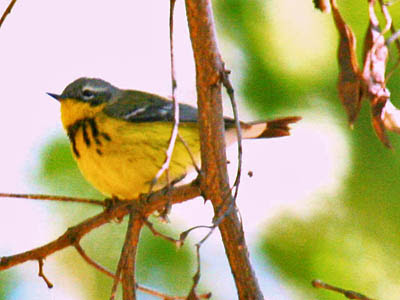 |
| Magnolia Warbler. Greg Gillson. |
Adult males are gray and black above and bright yellow below. Black mask and lower face. Gray crown. Black upper back. Black necklace that breaks into streaks down the breast. White under tail coverts. White under tail base, black terminal tail feathers. Large white wing patch.
Female with two wing bars, black mostly replaced with olive. Immatures for the first year lack black markings.
Live in moist coniferous forests, young stands of spruce and hemlock.
Magnolia Warblers are spring and fall migrants throughout Tennessee.
Wrapping Up
There are so many warblers with yellow in their coloring that I thought I would just look into that a little further:
The vibrant yellow plumage sported by many warbler species is not just a fashion statement, but a result of fascinating interplay between factors like diet, carotenoids, genetics, and evolution. Here’s a closer look at the reasons behind this sunny trend:
Diet and Carotenoids:
- Unlike most red birds, whose color comes from plant carotenoids, the yellow of many warblers stems from another pigment called xanthophyllin, particularly the type called lutein.
- These pigments are found in insects like caterpillars, leafhoppers, and aphids, a key part of the warbler diet.
- As warblers consume these insects, the xanthophyllin gets incorporated into their feathers during feather growth, creating the striking yellow hue.
Genetics and Expression:
- The ability to utilize and exhibit xanthophyllin varies among warbler species. Some genes control how efficiently birds can extract and deposit xanthophyllin in their feathers, leading to different shades and patterns of yellow.
- Additionally, genetic factors influence how other pigments interact with xanthophyllin, sometimes influencing the overall plumage color, like in the olive-yellow of some warblers.
Frequently Asked Questions
What kind of bird has a red chest in Tennessee?
The Rose-breasted Grosbeak offers a fascinating seasonal experience in Tennessee! While they migrate south for the winter, they grace the state with their vibrant colors and melodious songs during the spring and fall. Here’s where you might encounter these beautiful birds:
Breeding Season (May-July):
- Higher elevations in East Tennessee: Head to mountainous areas like the Great Smoky Mountains National Park, Unaka Mountain, or Roan Mountain. Look for them in hardwood forests with dense undergrowth, especially near clearings and edges.
- Frozen Head State Natural Area: Located above 3,000 feet in Roan Mountain, this area offers ideal nesting habitat for Rose-breasted Grosbeaks. Keep an eye out for them singing from treetops and searching for food in the forest canopy.
Fall Migration (August-September):
- Throughout the state: While less common than during breeding season, you can still encounter them in various habitats across Tennessee during fall migration. Look for them in wooded areas, parks, and backyards, especially where trees offer abundant berries and seeds.
- Riparian areas: Watch for them foraging along rivers and streams, where they may find insects and fruits.
- Bird feeders: If you have a feeder with sunflower seeds, safflower seeds, or millet, you might attract a visiting Rose-breasted Grosbeak during migration.
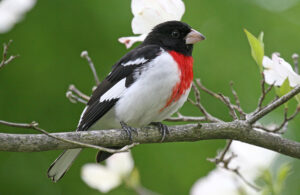
Why are American Redstarts called so when they are black and orange?
The name “American Redstart” can indeed seem a bit confusing at first glance, considering their predominantly black plumage with only splashes of orange! But fear not, there’s a fascinating story behind this discrepancy:
It turns out, the name doesn’t solely focus on their outward appearance, but rather highlights a specific behavior during their breeding season. When an American Redstart male defends its territory or attracts a mate, it flashes its bright orange tail feathers in a dazzling, fan-like display. This striking contrast against the black body creates a memorable visual signal, hence the “redstart” moniker.
Think of it this way: while they may not be entirely red all over, their key identifying feature and a crucial part of their behavior is indeed centered around that vibrant orange flash. It’s like calling a peacock a “fanned tail bird” even though its entire body isn’t feathers of that style – the eye-catching display defines the name.
What yellow bird is native to Tennessee?
Determining the native yellow bird in Tennessee requires considering the season and habitat factors. Here are some possibilities:
Summer Residents (May-September):
- Yellow Warbler: The most yellow of all North American warblers, they frequent shrubby areas, thickets, and forest edges.
- Prothonotary Warbler: A vibrant yellow bird with a black mask, found near swamps, rivers, and wet woodlands.
- Common Yellowthroat: A distinctive yellow warbler with a black mask and chest patch, inhabiting wet meadows, marshes, and shrubby fields.
Year-Round Residents:
- American Goldfinch: These iconic songbirds with bright yellow bodies and black wings are common in open fields, meadows, and backyards, especially during seed-rich seasons.
Winter Visitors:
- Evening Grosbeak: These large finches with yellow bodies and black wings can sometimes be found in coniferous forests during winter, attracted to pine seeds.
Related Articles:
See photos and learn about the most common backyard birds in Tennessee, regardless of color.
See photos and learn what to feed winter birds in Tennessee.
Here’s a quick tutorial of how I would teach you to identify birds: 7 Steps to Identify Birds!
Birds with red heads in North America.
Yellow-and-black birds in North America.






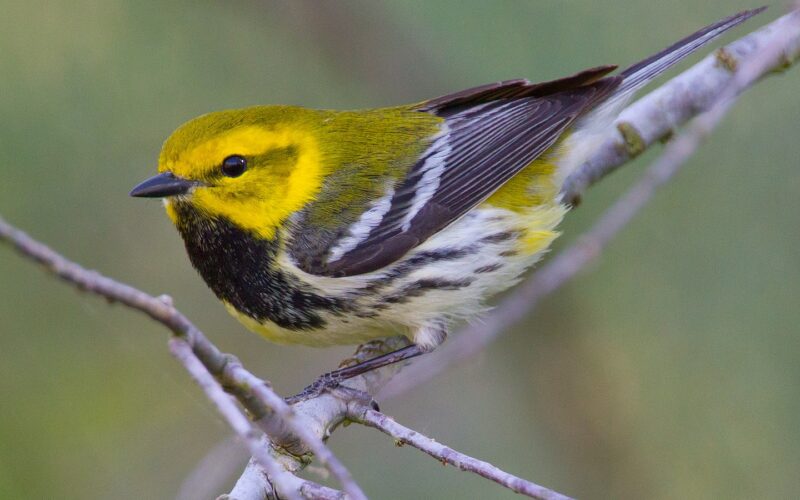
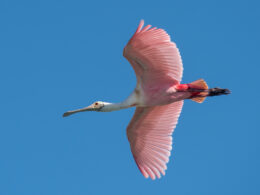
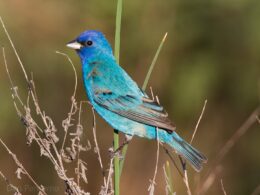
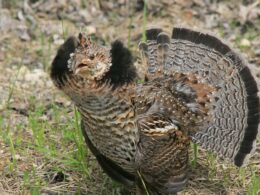
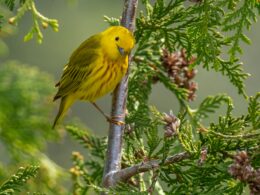
Can you please write an article about Indian birds (specially peacock, woodpecker,kingfisher, Mayna, Parrot,Dove etc). I also write blog but I like your writing skill.